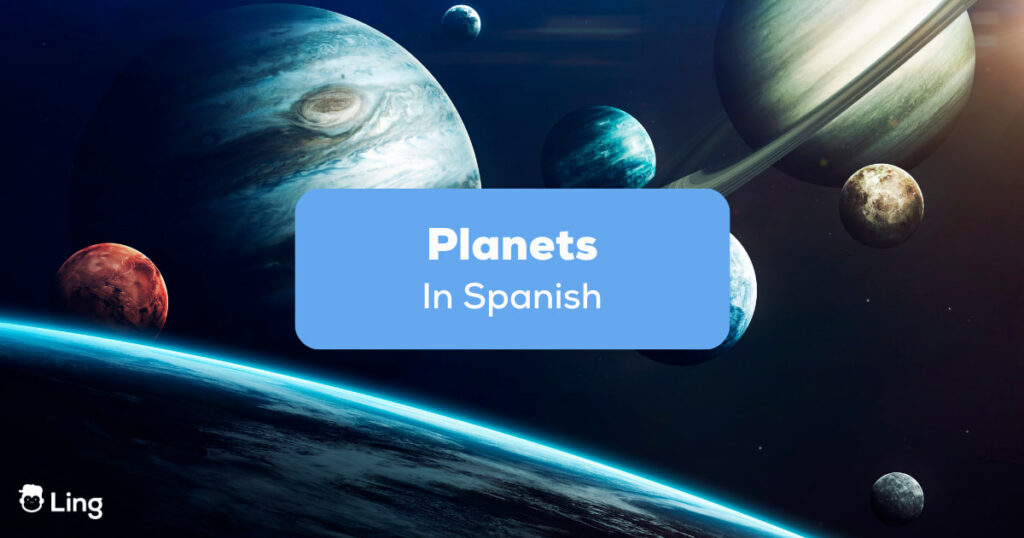The ancient Greeks gave them the perfect term: ‘planētēs,’ literally meaning ‘wanderers.’ Are you attracted to the mysteries of the Universe? Knowing how to name the planets in Spanish is a fun way to explore our solar system while improving your understanding and vocabulary of the language.
If astrology is your favorite subject, you will be able to have pleasant conversations about it with your Spanish-speaking friends without any hiccups or barriers to communication. Plus, you can show off your skills the next time you visit an astrological museum or planetarium.
Learning Languages Through Space
When thinking about the Universe, many of us feel an immense curiosity to get to know its secrets. Years go by, and new celestial bodies are discovered in the galaxies, but they remain unreachable. We can only get a telescope and see how beautiful the stars look on Earth. It is, without a doubt, a very interesting topic to cover when learning a new language.
In today’s blog, you will find the names in Spanish of the 8 planets of our solar system, plus words and phrases relevant to astronomy. Let’s get started!
Solar System Planets In Spanish
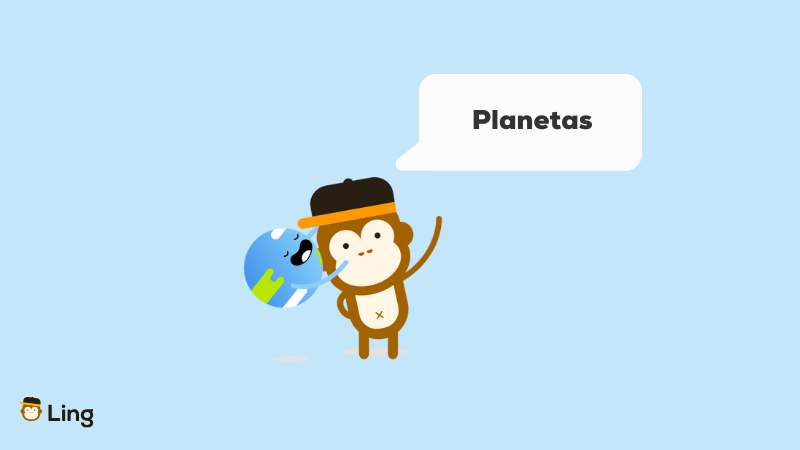
What Is The Spanish Word For Planets?
Before starting with the planets, we must learn how to say ‘planet’ or its plural ‘planets’ in Spanish. This vocabulary will be very familiar to you and quite easy to learn because the words that have to do with astronomy have Greek and Latin origins. Therefore, they are very similar in other languages with the same origins.
How Do You Say Solar System In Spanish?
Example sentence: ‘Nuestro sistema solar tiene ocho planetas que orbitan alrededor del sol.’ (Our solar system has eight planets that orbit around the sun.)
Note: As you noticed, both ‘Sistema’ and ‘Planeta’ end in the letter ‘a.’ If you are familiar enough with Spanish gender endings, you know that they are feminine when words end in ‘a.’
However, this is not the case with these two terms. They are considered masculine, and therefore you should never write ‘La Planeta’ or ‘La Sistema.’ Use ‘el’ (the) instead.
What Are The Eight Planets In Spanish?
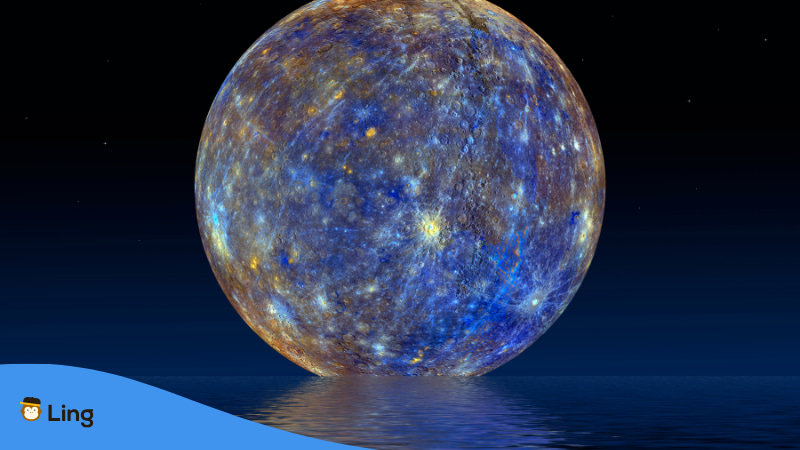
1. Mercurio – (Mercury)
Named after the God of speed and communication, ‘Mercury,’ known by the Greeks as ‘Hermes,’ the messenger of the Gods. It is the smallest and the closest planet to the Sun. You could compare its size to our moon, the moon being slightly smaller.
Some may think that it is the hottest planet because it is closest to the Sun, but this is not the case. In Mercury, temperatures can also become freezing because there is no atmosphere to retain the heat. So both cold and hot temperatures on this planet are extreme.
Example sentence: ‘Mercurio se está encogiendo.’ – (Mercury is shrinking.)
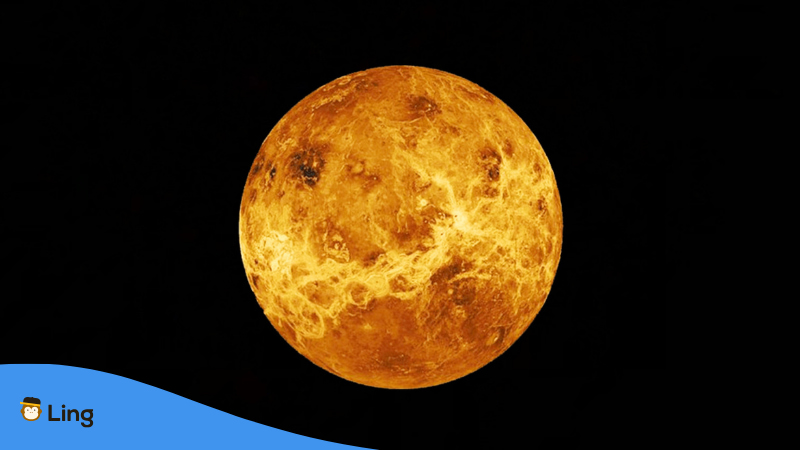
2. Venus – (Venus)
Its name refers to the Goddess of love and beauty ‘Venus,’ known by the Greeks as ‘Aphrodite.’ It is the second planet in the solar system and the closest to the Earth, and it is also the hottest planet.
One remarkable difference between Venus and Earth is that on Venus, the Sun rises in the west and sets in the east because its rotation axis is the opposite of the Earth. Also, one day on Venus is 243 days on Earth.
Example sentence: ‘Un día en Venus dura más que un año.’ – (A day in Venus lasts more than a year.)
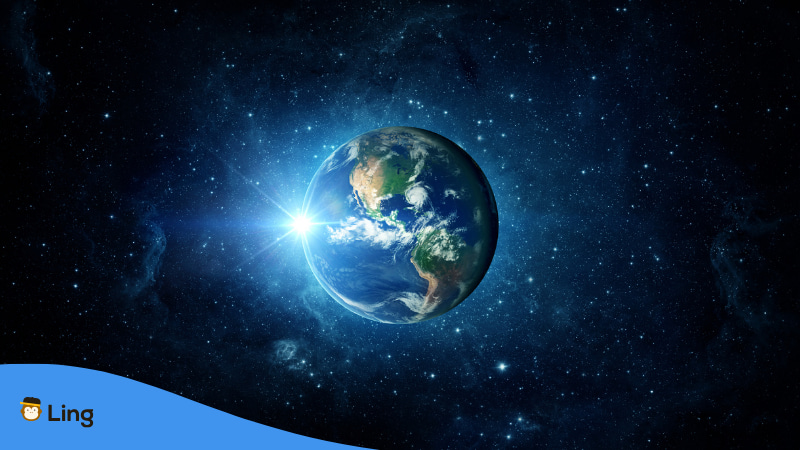
3. Tierra – (Earth)
Planet Earth, meaning ‘ground,’ in Germanic languages, is the fifth-largest planet and the only one known to have water, and therefore sustain life.
Compared to other planets, ‘La Tierra’ didn’t get a Roman God. However, it used to be called by the Romans’ Earth Mater,’ meaning ‘Earth Mother’ in English, or ‘Madre Tierra’ in Spanish. Many indigenous tribes across Latin America still refer to it as ‘Madre Tierra’ and its translation to indigenous languages, such as ‘Pacha Mama’ in the Quechua language.
Example sentence: ‘La rotación de la Tierra se está volviendo cada vez más lenta.’ – (Earth’s rotation is getting slower.)
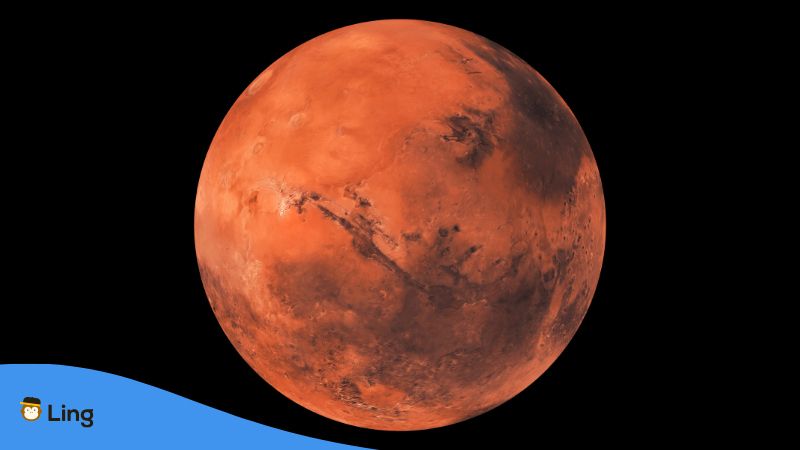
4. Marte – (Mars)
The Romans named it ‘Marte’ (Mars) after the Roman God of war.
El planeta rojo (The red planet), has been the fascination of so many people across centuries. It is full of rocks, mountains, deserts, and dust. Its average temperature during cold seasons can reach 50 degrees below zero.
Scientists believe it had once water and forms of life, according to evidence from previous studies that claim there were oceans and rivers, just like on our home planet.
Example sentence: ‘Marte tiene dos lunas.’ – (Mars has two moons.)
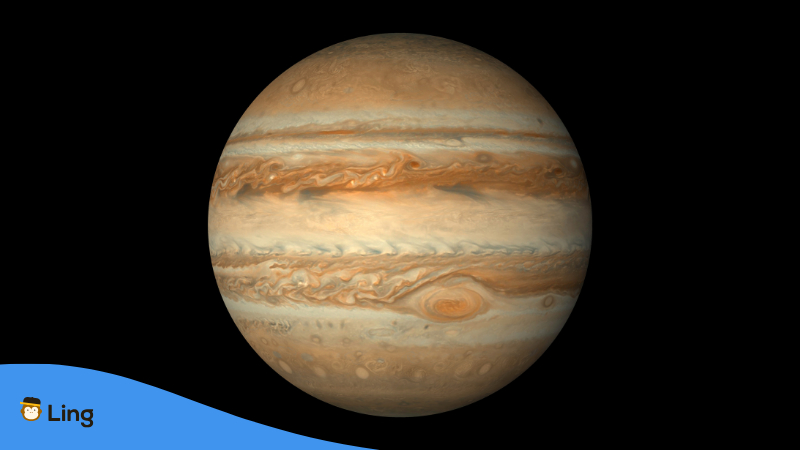
5. Júpiter – (Jupiter)
Jupiter is the biggest planet made of gas named after the ruler of the Roman Gods. If you see the image below, you will notice a red spot, known as the ‘Great Red Spot,’ which is an incredibly immense storm that, according to NASA, is bigger than the Earth’s size.
Its atmosphere is made of helium and hydrogen. Its non-solid surface includes ammonia ice, ammonium hydrosulfide crystals, and water vapor. Scientists believe that some of its 72 moons may have oceans beneath its crusts.
Example sentence: ‘La luna de Júpiter, Ganymede, es la mas grande del Sistema Solar.’ – (Jupiter’s moon, Ganymede, is the largest in the Solar System.)
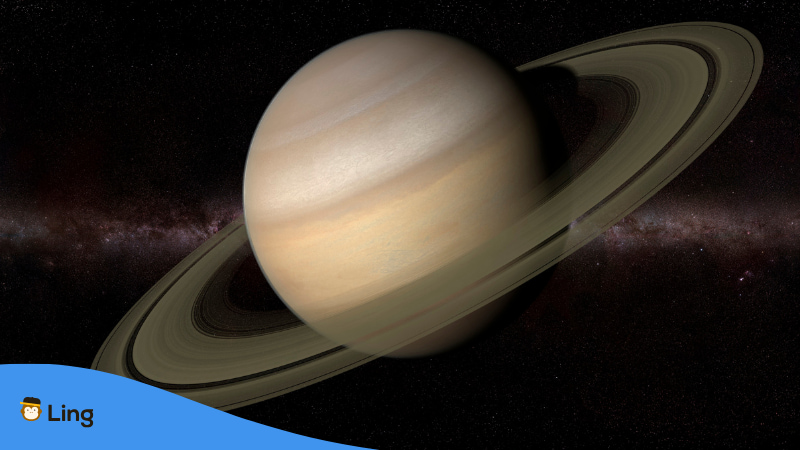
6. Saturno – (Saturn)
The God of Agriculture ‘Saturn’ is the father of Jupiter, and it is the name that the Romans chose for this planet.
Saturno (Saturn) is famous because of its beautiful and unique system of seven rings, known in Spanish as ‘Los anillos de Saturno’ (Saturn’s rings). A formation made of ice and rocks, first observed by Galileo Galilei, although he never described it as rings.
This planet is also a giant mass of helium and hydrogen. As it is made of gas, there is no solid surface. And if that isn’t interesting enough, scientists believe that there are 82 moons in total, as they are waiting to confirm 29, making Saturn the one with the most moons.
Surely you have heard of Saturn’s moon ‘Titan,’ which became famous after scientists discovered that it has water on its surface and that human beings would be able to walk around without a pressure suit. It is impressive to think that there could be life on any moon!
Example sentence: ‘Se cree que Saturno tiene 82 lunas.’ – (Saturn is believed to have 82 moons.)
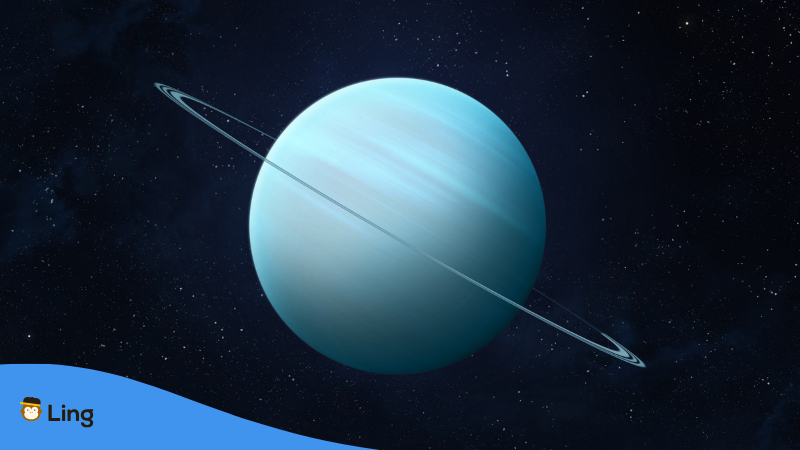
7. Urano – (Uranus)
When the astronomer William Herschel discovered Uranus (Urano) with his telescope, he thought it was a star or a comet until another astronomer confirmed that it was indeed a planet. Scientists named it Uranus after the Greek God of the Sky.
A fun fact about this planet is that it orbits on its side, making it a unique planet with the most extreme seasons in the whole solar system. In addition, when the Sun hits the pole, the rest of the planet is in darkness, with the strongest and coldest winter that lasts more than 20 years. According to NASA, its tilted orbit is because it may have had a collision with an object as big as the Earth.
Although Uranus also has rings, they are fainter than Saturn’s rings. What makes this planet astonishing is its bluish color due to the Methane in its atmosphere.
Example sentence: ‘Urano tiene la temperatura más fría registrada en el sistema solar.’ – (Uranus has the coldest temperature registered in the Solar System.)
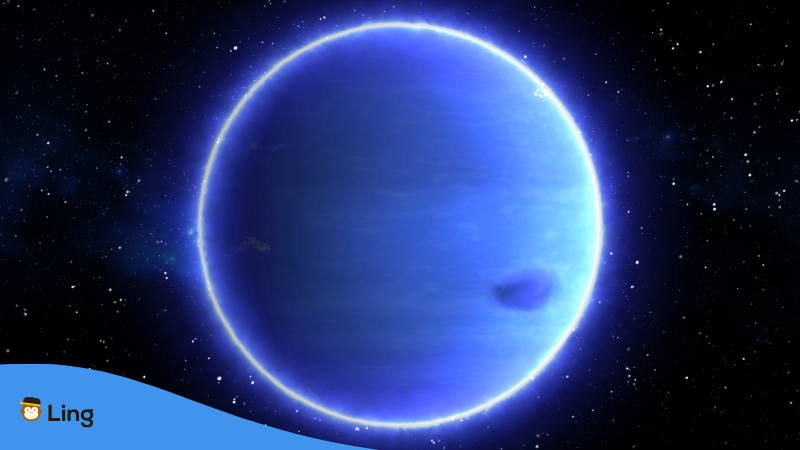
8. Neptuno (Neptune)
Neptune, named after the God of water, is the farthest planet, and until now, the last one in the solar system. Although, there are studies suggesting there might be a ninth planet. It is the first planet that wasn’t visually detected but predicted with math by the German astronomer Johan Galle.
Many believe that Neptune is the coldest planet. Even though it is dark and has freezing temperatures, Uranus still wins. However, Neptune is famous for its strong supersonic winds, which are three times stronger than the winds on Earth. The reason is that instead of receiving energy from the Sun, this planet generates even more energy, causing it to radiate from its core as strong winds.
Example sentence: ‘Las lunas de Neptuno tienen nombres de los personajes de las obras de Willian Shakespear y Alexander Pope.’ – (Neptune’s moons are named after characters of the novels by William Shakespeare and Alexander Pope.)
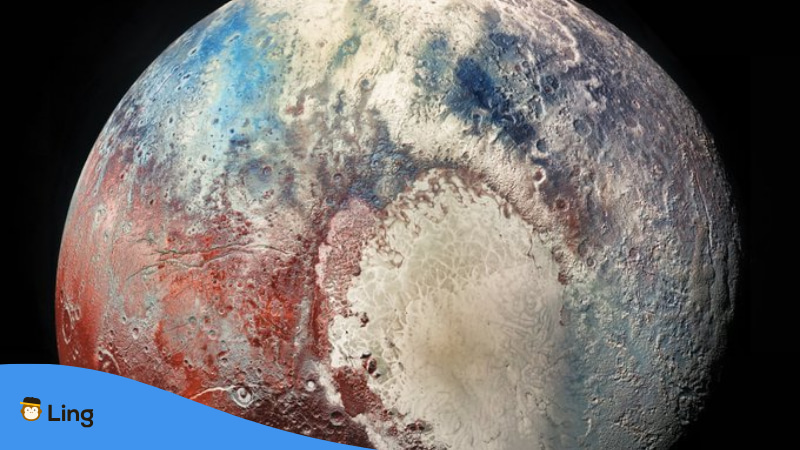
5 Dwarf Planets Of The Solar System (5 Planetas Enanos Del Sistema Solar)
The study of the solar system has advanced so fast that new celestial objects are discovered, and the list of planets as we know them is being modified.
Astrologers, before the year 2000, grew up thinking that there were nine planets in the solar system. But now, Pluto is not a part of the main list of planets, as it is considered a dwarf planet (planeta enano ).
When quickly naming all the planets, I can’t help but say ‘Pluto’ at the end because I’m so used to it. It must be the same for you as well.
So, since we cannot leave this planet behind, let’s learn which ones are the dwarf planets. You will notice that they do not have a translation to the Spanish language except for Pluto.
1. Plutón – (Pluto)
2. Ceres -(Ceres)
3. Makemake – (Makemake)
4. Haumea – (Haumea)
5. Eris – (Eris)
Possible Planets To Be Considered In This Category:
- Sedna – (Sedna)
- Quaoar – (Quaoar)
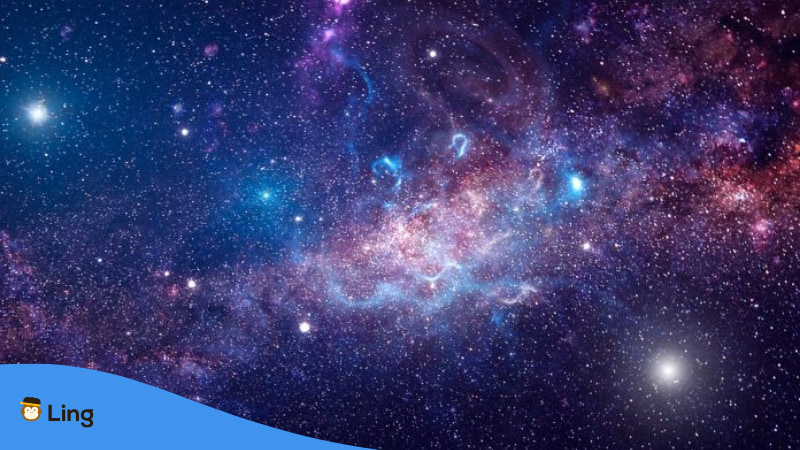
Galaxy Related Spanish Vocabulary
Get An Out Of This World Learning Experience With Ling!
Like a rocket going to the moon, your Spanish language knowledge will launch faster than ever with the Ling app. Take Ling with you everywhere you go and start learning useful daily life Spanish vocabulary, phrases, grammar, and pronunciation prepared by expert native speakers.
You will see how fun it becomes to learn a new language once you start experiencing the lessons and quizzes that Ling has prepared for you.
You will get a variety of topics to learn different vocabulary, such as naming the planets in Spanish, key phrases for tourists, food, animals, weather, and so much more! So don’t wait any longer to gain your desired level of Spanish.
Download the app on the Play Store or App Store to get your lessons and learn Spanish today!
